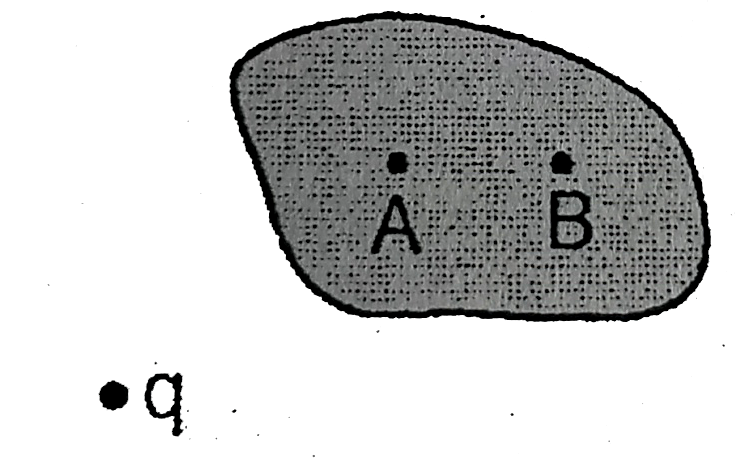Assertion:- A point charge q is placed near an arbitary shaped solid conducot as shown in figure. The potential difference between the points A and B within the conductor remain same irrespective of the magnitude of charge q

Reason:- The electric field inside a solid conductor is zero under electrostatic conditions.
Statement-1 is true, Statement-2: is true, Statement-2 is a correct explanation for Statement-1.
Statement-1 is true, Statement-2: is true, Statement-2 is NOT a correct explanation for Statement-1.
Statement-1 is true but statement-2 is false
Statement-1 is false, Statement-2 is true
The correct Answer is:A
(Easy) Since electric field inside the conductor is zero, A and B are always at same potential.
Hence VA−VB=0 . Hence statement-1 and 2 are true and statement-2 is correct explanation of statement-1
Topper's Solved these Questions
Similar Questions
Assertion:A point charge q is placed near an arbitrary shaped solid conductor as shown in figures.The potential difference between the points A and B within the conductor remain same irrespective of the magnitude of charge q
Reason: The electric field inside a solid conductor is zero under electrostatic conditions

View SolutionPositive and negative charges of 1μC each are placed at two points as shown in the figure. Find the potential difference between A and B

View Solution
Knowledge Check
Assertion: The potential difference between the two conductors of a capacitor is small.
Reason : A capacitor is so configured that it cofines the electric field lines within a small region of space.AIf both assertion and reason are ture and reason is the correct explanation of assertion.BIf both assertin and reason are ture but reason is not the correct explanation of assertion .CIf assertion is true but reason is false.DIf both assertion and reason are false.
A point charge Q is placed at the point O as shown in Fig. Is the potential difference (V)A−VB) positive, negative or zero if Q is (i) positive (ii) negative ?

View SolutionA point charge Q is placed at the point O as shown in Fig. Is the potential difference (V)A−VB) positive, negative or zero if Q is (i) positive (ii) negative ?

View SolutionA short dipole of dipole moment P is placed near a point charge Q as shown in figure. Find force on the dipole due to the point charge

View SolutionA short dipole of dipole moment P is placed near a point charge Q as shown in figure. Find force on the dipole due to the point charge

View SolutionDetermine the potential difference VA−VB between point A and B of the circuit shown in figure . Under what condition is it equal to zero ?

View SolutionA uniformly charged non-conducting spherical shell is given +q charge and a point charge -q is placed as shown. The electric field lines will be

View SolutionA spherical conductor having charge q and radius r is placed at the centre of a spherical shell of radius R and having charge Q (R > r). The potential difference between the two is
View Solution
